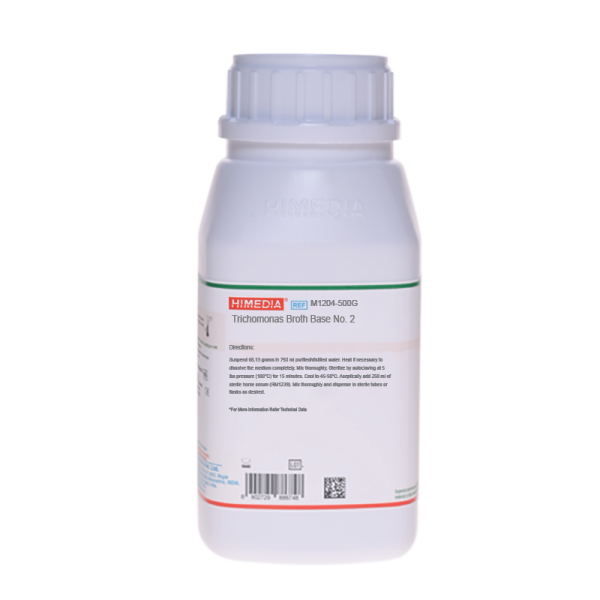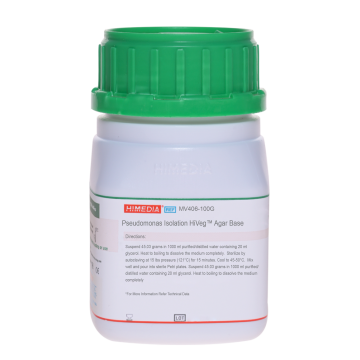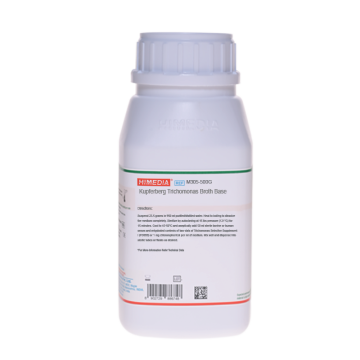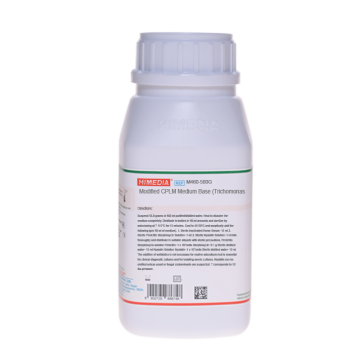 Your enquiry has been submitted
Your enquiry has been submitted
Trichomonas Broth Base No. 2
Protozoa#CC293D
Intended Use:
Recommended for the isolation of Trichomonas vaginalis.
Composition**
| Ingredients | g/L |
|---|---|
| Dextrose (Glucose) | 22.500 |
| HL digest # | 18.000 |
| Tryptone | 17.000 |
| Sodium chloride | 5.000 |
| Soya peptone | 3.000 |
| Dipotassium hydrogen phosphate | 2.500 |
| Chloramphenicol | 0.125 |
| Calcium pantothenate | 0.005 |
| Final pH (at 25°C) | 6.2±0.2 |
**Formula adjusted, standardized to suit performance parameters # Equivalent to Liver digest
Directions
Suspend 68.13 grams in 750 ml purified/distilled water. Heat if necessary to dissolve the medium completely. Mix thoroughly. Sterilize by autoclaving at 5 lbs pressure (108°C) for 15 minutes. Cool to 45-50°C. Aseptically add 250 ml of sterile horse serum (RM1239). Mix thoroughly and dispense in sterile tubes or flasks as desired.
Principle And Interpretation
Trichomonas Broth Base No.2 is used for the isolation of Trichomonas Vaginalis (1). Stenton reported that incorporation of liver digest in the medium plays an important role in detection of Trichomonas vaginalis (2).
Addition of Horse serum makes the medium highly nutritious got T. vaginalis. The medium is equally suitable for the examination of urethral and vaginal swabs and urine specimens. Tryptone and soya peptone and HL digest provide the nitrogenous substances. Glucose acts as the energy source. The selective agent chloramphenicol is inhibitory to gram-positive and gram-negative bacteria but not for Trichomonas species. Sodium chloride maintains the osmotic equilibrium of the medium. Dipotassium phosphate buffers the medium. Calcium pantothenate acts as a growth factor. The small amount of agar helps to create anaerobiosis. Under anaerobic conditions massive inocula are required.
Type of specimen
Clinical samples - vaginal and urethral secretions (women), anterior urethral or prostatic secretions (men)
Specimen Collection and Handling:
For clinical samples follow appropriate techniques for handling specimens as per established guidelines (3,4). After use, contaminated materials must be sterilized by autoclaving before discarding.
Warning and Precautions :
In Vitro diagnostic Use only. For professional use only. Read the label before opening the container. Wear protective gloves/protective clothing/eye protection/ face protection. Follow good microbiological lab practices while handling specimens and culture. Standard precautions as per established guidelines should be followed while handling clinical specimens. Safety guidelines may be referred in individual safety data sheets.
Limitations :
- Under anaerobic conditions massive inocula are required.
Performance and Evaluation
Performance of the medium is expected when used as per the direction on the label within the expiry period when stored at recommended temperature.
Quality Control
Appearance Light yellow to light brown homogeneous free flowing powder
Colour and Clarity of prepared medium Dark amber coloured clear solution in tubes
Reaction Reaction of 6.81% w/v aqueous solution at 25°C. pH: 6.2±0.2
pH 6.00-6.40
Cultural Response
Cultural characteristics observed after an incubation at 35-37°C for 3-5 days with added Horse serum (RM1239).
| Organism | Growth |
|---|---|
| Candida albicans ATCC 10231 (00054*) | good-luxuriant |
| Escherichia coli ATCC 25922 (00013*) | inhibited |
| Trichomonas vaginalis ATCC 30001 | good-luxuriant |
Key: *Corresponding WDCM numbers.
Storage and Shelf Life
Store between 15-25°C in a tightly closed container and the prepared medium at 2-8°C. Use before expiry date on the label. On opening, product should be properly stored dry, after tightly capping the bottle in order to prevent lump formation due to the hygroscopic nature of the product. Improper storage of the product may lead to lump formation. Store in dry ventilated area protected from extremes of temperature and sources of ignition. Seal the container tightly after use. Product performance is best if used within stated expiry period.
Disposal
User must ensure safe disposal by autoclaving and/or incineration of used or unusable preparations of this product. Follow established laboratory procedures in disposing of infectious materials and material that comes into contact with clinical sample must be decontaminated and disposed of in accordance with current laboratory techniques (3,4).
Reference
- Ronald M. Atlas : Handbook of Microbiological Media 3rd edition CRC Press.
- Stenton P, 1957, J. Med Lab. Technol, 14:228.
- Isenberg, H.D. Clinical Microbiology Procedures Handbook 2nd Edition.
- Jorgensen, J.H., Pfaller, M.A., Carroll, K.C., Funke, G., Landry, M.L., Richter, S.S and Warnock., D.W. (2015) Manual of Clinical Microbiology, 11th Edition. Vol. 1.
| Product Name | Trichomonas Broth Base No. 2 |
|---|---|
| SKU | M1204 |
| Product Type | Regular |
| Physical Form | Powder |
| Origin | Animal |
| Packaging type | HDPE |
| References | 1.Ronald M. Atlas : Handbook of Microbiological Media 3rd edition CRC Press.2.Stenton P, 1957, J . Med Lab. Technol, 14:228. |
| Customized Product Available | No |







